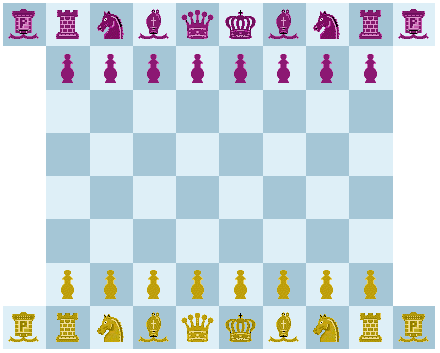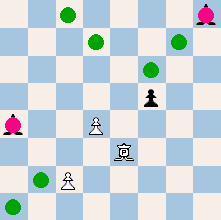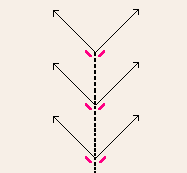

The Pegniar is a bifurcation piece. It always moves in two legs; the first is an orthogonal slide, and the second is a diagonal bounce-move, along either of two diagonals in the prolonged movement-direction. If the Pegniar cannot bounce, then it cannot move. The Pegniar's value is 3, that is, the same as a bishop or knight (preliminary estimate). While the Pegniar slides along an orthogonal, several diagonals (in the prolonged movement direction) could be chosen, provided that there exist screens for bouncing. The Pegniar also moves by bouncing against the side of the board. In this case there is only one diagonal movement direction available. Other rules are the same as in standard chess, except for the possible promotion to Pegniar. The Pegniar is a highly cooperative piece, something which makes it interesting to the positional player. Although the Pegniar is dependent on screens for moving it is a very dynamic and difficult piece that puts great demands on the chessplayer. Pegniar Chess, and the new Pegniar piece, were invented by undersigned, September 2006.
The Pegniar (lat. Pægniarius) was a gladiator type in ancient Rome, which was equipped with club, whip, and shield.
 The Pegniar always moves in two legs, the first is an orthogonal slide and the second is a diagonal bounce-slide (red = capture).
The Pegniar always moves in two legs, the first is an orthogonal slide and the second is a diagonal bounce-slide (red = capture).
 The Pegniar's movement principle. In any of its four orthogonal movement directions, there could be many screens to choose from. The screens, that are used for bouncing, occur anywhere on the first leg.
The Pegniar's movement principle. In any of its four orthogonal movement directions, there could be many screens to choose from. The screens, that are used for bouncing, occur anywhere on the first leg.
• You can download my free Pegniar Chess program here (updated 2007-02-14) , but you must own the software Zillions of Games to be able to run it (I recommend the download version).
• Don't miss my other chess variants.
© M. Winther (September 2006).